How to arrange a title page step by step. How to write and format an essay, report and other independent work of students.
The title page is the first page of the work that precedes its content. Title pages are drawn up in accordance with GOST 7.32-2001 “Report on research work. Structure and design rules "and GOST 2.105-95" Unified system for design documentation ". Interestingly, the latter not only acts in Russian Federation since July 1, 1996, but also adopted in Belarus, Ukraine, Kazakhstan.
GOST does not regulate the type of font in any way, but, as a rule, Times New Roman font with a character size (point size) of at least 12 pt is used for typing the title page (usually the font size is set to 14 pt). In this case, both lowercase and uppercase (uppercase) letters can be used. So the words "Ministry of Education and Science of the Russian Federation" (or any other country), the name of the educational institution and the topic of work are usually typed exactly in capital letters, the rest of the information is in lowercase. However, the requirements for title pages may differ depending on the institution, so you need to be careful.
Rules for the design of GOST title pages
Despite these differences, there are certain rules for the design of title pages, which are the same for all educational institutions. So any "title" should contain the following information:
- full name of the educational institution;
- the name of the department;
- the name of the discipline;
- topic of work;
- FULL NAME. the author of the work;
- course or class number;
- form of study (full-time, part-time, evening);
- sequence number of the group;
- FULL NAME. teacher with an indication of his position;
- locality;
- year of writing the work.
You also need to take into account that even though the numbering of the pages of the work begins from the title page, the serial number is not put on it!
Procedure for registration of the title page
The process of decorating the title page looks like this:
- At the top of the page we type the name of the university with all the "caps" in capital letters. Highlight it in bold, align it to the center (recall, font Times New Roman, single spacing).
- We indicate the type of student work (coursework, diploma, control, essay, etc.).
- Writing the topic of the work.
- Next, we indicate the author and the teacher (often using the words "completed" and "checked").
- At the very bottom, we register the city in which the educational institution is located, and the current year.
- We set the margins of the title page (the size of the margins for the title page: left - 30 mm, right - 10 mm, top and bottom - 20 mm).
By the way! For our readers now there is a 10% discount on
The result should be something like this spherical "title" in a vacuum, i.e. in Word:
Of course, the samples of title pages can vary significantly depending on the methodological recommendations drawn up in different universities. However, if you complete your title page according to the above model, no one should find fault with you, tk. this will be done strictly in accordance with GOSTs.
Title page of thesis, samples from various universities:
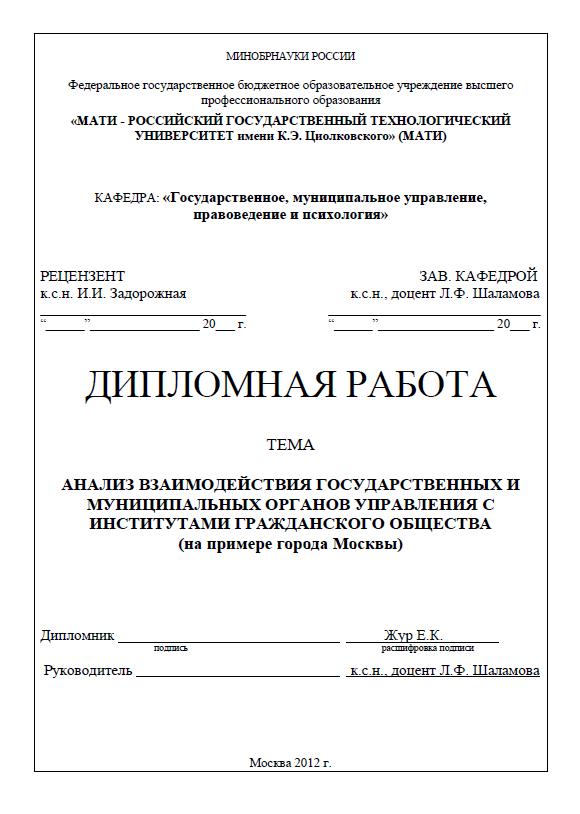
Sample 1
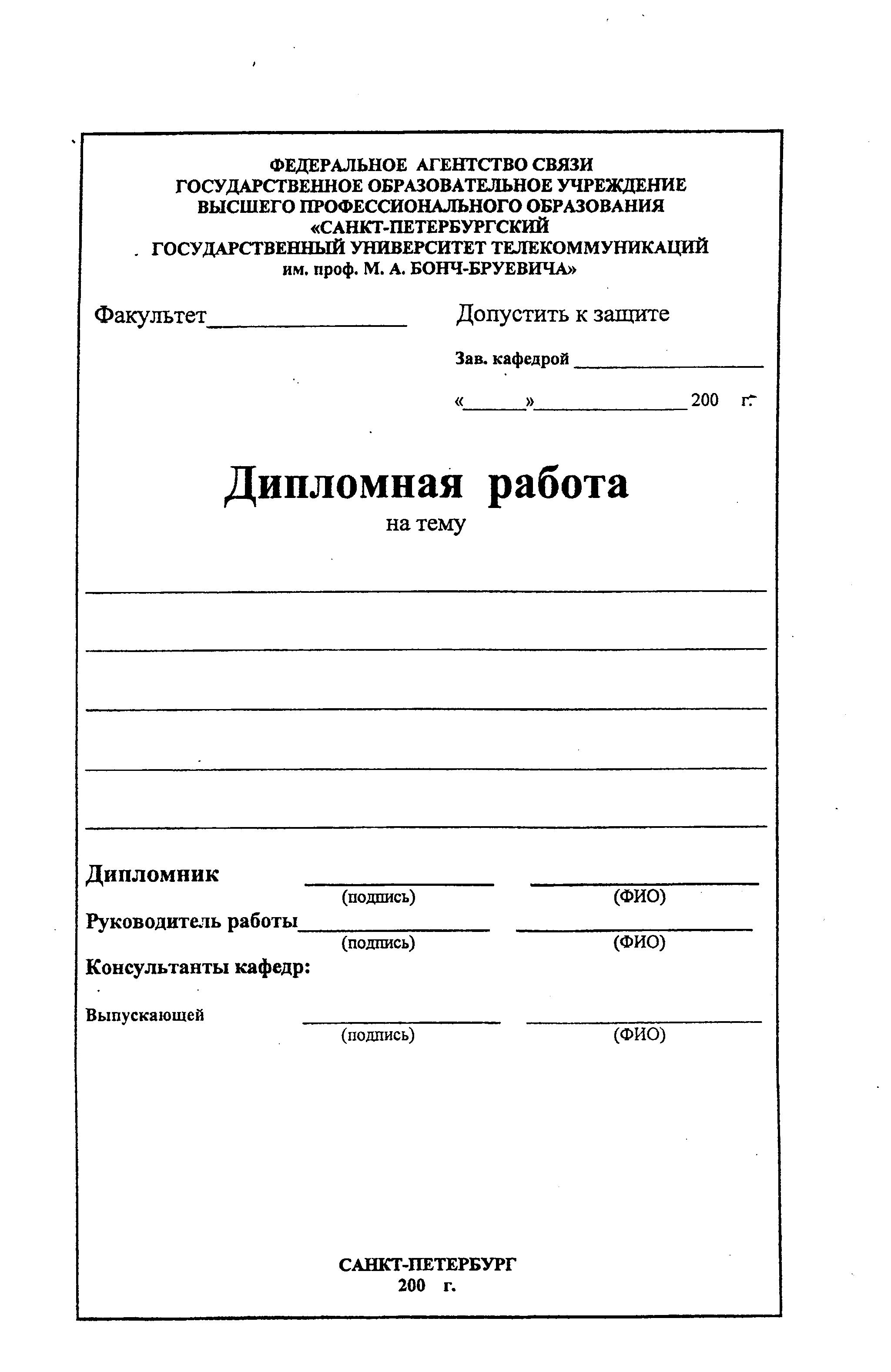
Sample 2
You can download such a sample of the title page of the thesis.
If you do not want to make the "title" yourself, you can download the template for the title page of the thesis.
Title page of coursework, samples from various universities:
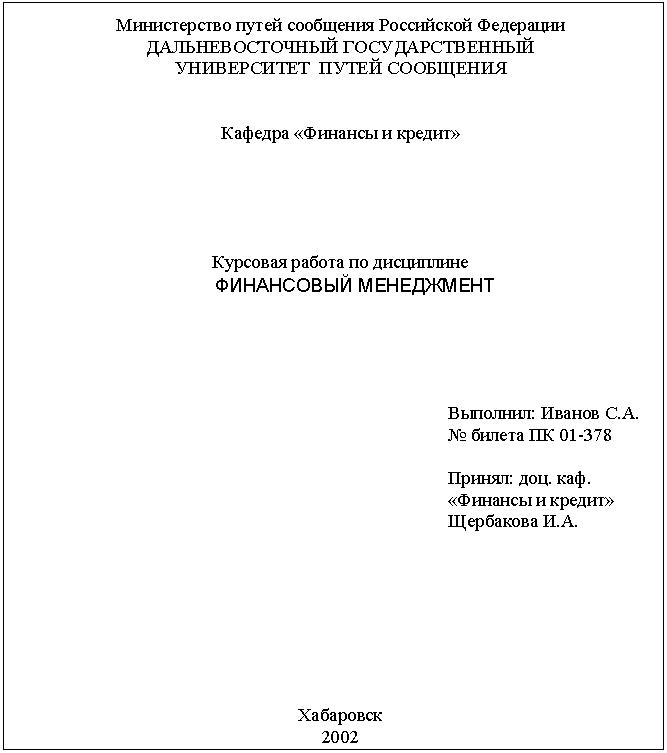
Sample 1
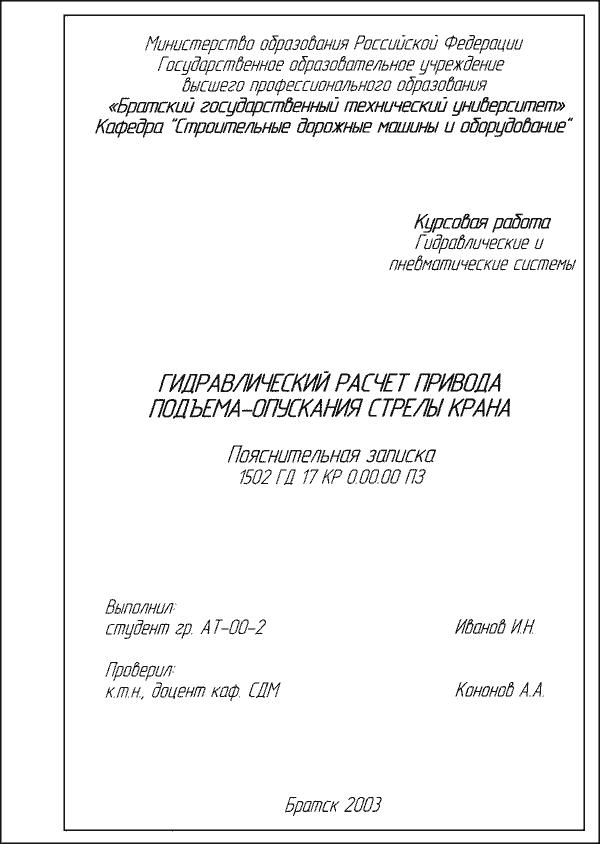
When writing a creative or scientific project, there are strict rules for the design of the title page: you must indicate your scientific advisor, the name of the educational institution, the year of completion of the work and the full name. How exactly to place this data on the sheet and what fonts to use, you will learn in this article.
Start writing your title page: go to microsoft program Office Word or whichever is more convenient for you, and set the Times New Roman font to size 16. Note the alignment of the text in the center.Write the full name of your educational institution, you can inquire about it on the Internet or in advance from your scientific consultant.
You should make the page markup that complies with the design rules. Go to the "Page Layout" tab in the program header and select the "Fields" box. At the very bottom of the list, you will see the line "Custom Fields".
- Align top and bottom by 15 mm.
- Right 10 mm.
- Left 20 mm.
This will make your project look the most accurate, and in the future you will have the opportunity to flash it on the left side.



Set the font back to 16 and align it to the right. Enter your name after "Author:" and the name of the scientific advisor after "Consultant:". Remember to put a colon and bold those words.
Names are indicated with initials.


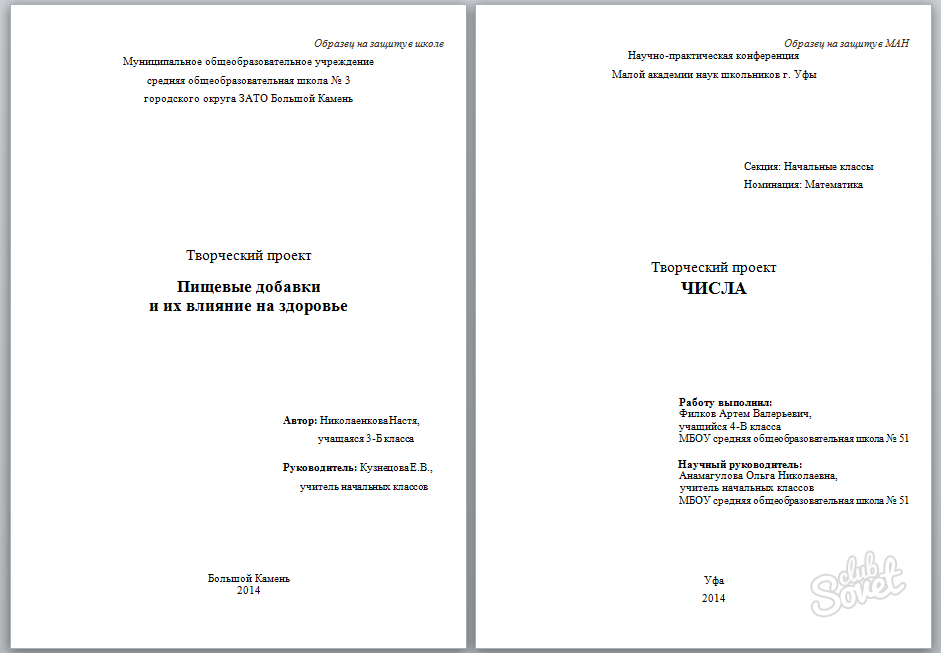
Check with your consultant in advance how to record their role in your work. If the instructor gave you advice and guidance throughout the entire work on the project, then, more often than not, he fits in exactly as a consultant. In serious and voluminous works for scientific conferences, a teacher can be registered as a "Researcher" if he took a direct part in writing the work.
You can see a little other design options in the short video below:
This is a post-memo. First of all for ourselves. It contains the recommendations and requirements adopted in our schools and other educational institutions when writing a written independent work by a student. We used these rules, starting with elementary school for writing essays and reports and ending with my term papers and theses in university.
Here I have collected the most basic answers to questions: how to write, what to write, how to design. If you are in your educational institution did not give any special instructions on writing a work, then these rules can be taken as a basis - they are the most common. All these recommendations have been checked and tested on ourselves - every year our projects win prizes in city and republican competitions largely due to a correctly written report (for example, the report "Research of asteroids" (grade 8), "" (grade 7), "" (6 class), "" (4th grade), "Study of the earthworm" (1st grade)).
It is not enough to choose an interesting topic, it is not enough to stage experiments and experiments, it is not enough to conduct research. It is necessary to be able to describe and formalize it correctly (for this, certain points are given, which will then be taken into account in the overall assessment).
Of course, it is best to take the methodological instructions and rules for the preparation of works at the very competition or in the educational institution where it will be held. Therefore, my advice here is just mine personal experience writing works, they do not pretend to be a sample :)
Requirements for registration of work.
The work is written on a computer and printed on sheets plain office paper A4.
Fields: left 2.5 cm, right 1.5 cm, top and bottom 1 cm each.
Pagination:in the lower right corner. The number is not written on the title page.
Text font: Times New Roman, 14 pt.
Line spacing: one and a half.
Total workload: up to 20 pages.
The title page is designed as follows:
The work plan is drawn up as follows:
(I personally prefer to number sections with numbers, but you can do without it). Introduction, conclusions, bibliography and appendices are not numbered.
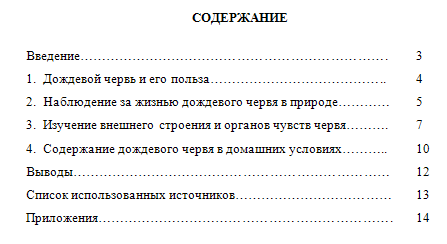
The main content of the work is formalized as follows:
Each point of the plan begins with a new sheet. The name of the item must exactly match the way it is written in the plan. First, the title is written: in the center of the line in all capital letters and highlighted in bold. The font and requirements are the same as for regular text.
After the title comes the text itself.
The list of references is made out as follows:
The rules for making a list of references are the most complex and contradictory rules in the world :) A special GOST has been developed for them, which is easy to find on the Internet. But personally, we usually perform them in a somewhat simplified version and no one has ever made comments to us.
Pay close attention to where to put which punctuation marks and where to use capital letters - this is very important. Also, keep in mind that the list first writes "paper editions" in alphabetical order, then electronic resources in alphabetical order.
So, different types of literature are formatted as follows:
Book without author (title, definition, editor (compiler, etc.), city of publication, publisher, year of publication, total number of pages):
1.
Space: encyclopedia. / ed. Melnikov M.D. - M .: "Makhaon", 2004. - 180 p.
Author's book (author (or several authors), title, city of publication, publisher, year of publication, total number of pages):
1.
Siegel F.Yu. Treasures of the starry sky. - M .: "Science", 1980. - 312 p.
An article in a journal or newspaper (author, title of the article, title of the journal, number, date, pages on which the article is placed):
1.
Rogozin D. Space tourism: the number of people willing is not decreasing. // Universe, space, time. - No. 5 (83). - 2011. - S. 22-25.
Link to an electronic resource (article title, site name, site url):
Now let's move on to the very content of the work: how to write.
I will write a very thesis structure of any scientific research - it is suitable for both the exact sciences and the humanities. In any case, the canvas remains alone. It is suitable for any student's age, just for an elementary school it will be enough to reveal each item in a couple of sentences, and for a more serious level, a widespread description will be needed. But the essence remains the same.
1. You must select topic of work... It will be reflected in the title of your report.
Any work must necessarily contain your independent development
... Even if you take some long-known topic or experiment, think about what exactly will be noveltyexactly your approach. And what part of the job your child will be able to do it himself and then explain on his own members of the receiving committee on defense. Oddly enough, even competitions of a very serious level are sinned by the fact that they contain works that are simply taken from the Internet without any attempt to do something ourselves. For example, this is exactly what happened with Katya's report "Studying an earthworm at home" - the next year, at the defense at the competition, we met a work with exactly the same experiments about the worm, taken from my blog, and the same canvas. Can you imagine our shock?
And when choosing a topic, think about whether you need to grow salt and copper sulphate crystals with your child for the hundredth time, or make a volcano from soda and vinegar? Members of the commission annually accept ten such standard reports.
And think about whether it is necessary to give the child a topic to understand which he has not yet matured? The desire of parents to take a serious topic for the report is commendable. But if, as a result, the entire scientific apparatus was written by mom, all the visual materials were made by dad, and the child was only left to read the prepared text from a piece of paper like a parrot, then is there any point in such work? Again, it comes to the ridiculous: the child on the defense talks about a phenomenon that is described by complex mathematical formulas, and he himself does not even know the meanings of the terms. And this becomes clear at the first additional question.
Each application is given on new page... They can be numbered with letters: Appendix A or numbers: Appendix 1.
When you calculate the volume of work, sheets with attachments are not taken into account (i.e. if you were asked to write a fixed volume, for example, 10 pages, then the title page, plan, introduction, conclusion and bibliography are included there, but attachments are not. maybe 15 pages if you include attachments)
What documents and materials do you need to complete?
Each competition has its own requirements, they must be found out in advance. But usually the standard procedure is as follows - you must submit:
1. Application to participate in the competition
2. The organizing committee (or whoever holds the competition there) must provide abstracts (a very concise description of the work: its title, authors, leader, its goals, objectives and conclusions) - all no more than one A4 sheet.
3. The organizing committee must pass one copy of the report and a disk with the presentation of the report recorded on it(the second copy of all this must be taken with you to defend the report on the day when the speeches will be heard)
4. To make an oral presentation before the commission - protection of work
And, finally, how is this defense of work carried out?
The performance should take 5-7 minutes... Not more! Some commissions adhere very strictly to the rules and directly stop children when the time is up.
Protection is usually accompanied by a computer presentation made in Power Point (ppt) format - you must bring it with you on a flash drive. The presentation is displayed on a large screen so that everyone present can see it. It will be good form if the child, during his presentation, refers to the presentation - to show some data, a photo on it, and not just read his own text separately, and the presentation will go behind only in the background.
Visual aids: model, experimental results, at least a diagram or poster. It is only necessary that the child himself participated in its manufacture, although the help of adults is allowed.
After the performance, additional questions, the answers to which are also evaluated by the commission.
Moreover, the activity at the hearings is also usually assessed - i.e. need and ask questions to other speakers.
The criteria for evaluating the performance are as follows (copying from a piece of paper in 2014):
1. Level of independence
2. The level of novelty and originality of the idea or methods
3. Systematic presentation of the material
4. The culture of the student's speech
5. Completeness of answers to additional questions.
6. Activity (that is, you have to ask the speakers questions yourself).
That's it - on the one hand, everything is simple, on the other, you need to know this so that your interesting and useful work is not deducted extra points due to nonsense: an incorrectly drawn up title page or the absence of plan points.
Successful writing of your work!
The importance of the question.
As a rule, students face a similar problem at the beginning of their studies. In the first, maximum - in the second year of the institute. Often, after receiving an assignment to do a job, a freshman does not know how to start doing it. You have to spend a lot of time worrying. All this can distract attention from writing the abstract itself. The loss of time as a result will result in a loss of the quality of the work itself.
Therefore, it is advisable to study the rules for the design of the title page, to have a sample of its design with you. Moreover, over the course of decades, no special innovations have been introduced into the regulations for the design of the first sheet of work.
Much depends on the quality and correct design of the first - title page. First, it is the face of your work. It shows how responsibly you were in completing the assigned task.
Secondly, experienced teacher already by the appearance of the first sheet, he can quite accurately assess the work itself, its quality and the correctness of writing.
And thirdly, you need to learn always and in everything. The habit of doing all the work “from cover to cover” at the highest level develops such important character traits as dedication, responsibility, punctuality and conscientiousness.
Guiding documents.
All basic requirements and features for the design of the title page of the abstract are defined in GOST 7.32-2001. The document is titled: “Research Report. The structure and rules of registration ”, and reveals in detail how it should be. Therefore, before starting work, in order to eliminate errors, you should study this document. Well, for those who prefer a more detailed and visual study of the issue to dry numbers and laconic instructions, our article has been prepared.
Primary requirements.
So the first step is padding. In order for the finished abstract to be sewn into one brochure, it is necessary to indent on the right by 30mm. On the right, the size of such an indent is set to 10mm, and the top and bottom are the same, 20mm each. This is the distance to the frame, which is recommended for classic traditional style. And already inside the frame, they have all the necessary information.
Point number 2. - font. The generally accepted font for the design of the entire abstract as a whole, and the title page in particular, is Times New Roman. If the text of the abstract itself uses the 14th size of this font, then for the design of the title page, it is possible to use different sizes, as well as bold, underline, etc.
Components.
For better assimilation, let's conditionally divide the title page into parts. Let's consider each separately.
At the top of the sheet.
We indicate the name of the Ministry in whose jurisdiction this educational institution is located.
Slightly lower, indented by 1 space - in big letters the name of the university itself is written.
Both lines are centered.
registration of the title page of the abstract.
Sample title page
Ministry of Culture of the Russian Federation
Saint Petersburg Art Restoration College
abstract
By discipline:
(the name of the discipline is indicated)
(This line specifies the exact topic of your work)
Completed:
Student (_) course, (_) groups
Full Name
Scientific adviser:
(Position, department name)
Full Name
Grade _____________________
The date _____________________
Signature ____________________
St. Petersburg
Middle of the title page.
It should also be centered. It states here:
- The word "ABSTRACT".
- by discipline:
- "further the name of the discipline itself"
- on the topic: (a colon is required)
- the exact wording of the selected or given topic of the abstract is indicated
As a result, all information should be located on at least 5 lines (or more if the topic of the abstract does not fit into one line). There should not be any quotation marks on the title page. And the word "ABSTRACT" is allowed to be prescribed
16 font, as it should stand out against the general background, as the main thing on the page.
Bottom part.
It is formatted after indenting two intervals (by double pressing the Enter key).
Further, all records are made as indicated on the sample. Note the alignment of the text in this section. The design rules allow alignment, both to the right and to the left. However, this does not mean the edge of the sheet, but a conventionally created table in which this block of the title page is located. Here, within the framework of this table, you can align to the left (as shown in the sample).
And the last thing: at the very bottom of the page, you indicate the city in which the university is located, as well as the year of writing the abstract.
Output:
We have already noted the importance of knowledge and ability to correctly draw up the title page of the abstract. We can only add that many educational institutions (especially higher ones) allow the introduction of their own characteristics. They may slightly, but differ from GOST, therefore, before drawing up the first sheet of work, contact your manager and check with him if there are any such differences!
Many freshmen have problems with the correct presentation of a report or abstract. Very often, having received an assignment to write an essay, a student thinks about how to draw up a title page. The key to a good grade is not only the text of the abstract, but also an impeccably composed title page. Since the abstract is a scientific work, its design must be at a high level. First of all, the title page should be neat. Further, on the left of the sheet, we leave a place for the binding. Indents must be made on all pages. It will be better if you take the indent on the left by three centimeters, above and below - two, and on the right side - one and a half centimeters.
How to arrange the title page of the abstract?
Moving on to the choice of size and font. The usual font for text is twelve. However, we need to choose a large font for the title. As a rule, we use TimesNewRoman by standard. Next, you need to highlight the name in bold or italics. When choosing a creative topic, you can make the headline original using different styles, and it is best to consult with your teacher beforehand. When writing a serious topic, a standard design without any frills will be correct.
How to correctly draw up the title page of the abstract? To give the title page a beautiful appearance you can make a frame. The frame is best to choose three-dimensional or with drawings, but in a classic style. Next, we move on to entering text. There is a state standard for formatting cover page... However, it happens that higher educational institutions set their own standards for its preparation. In order to correctly draw up the title page of your abstract, it is better to take a sample from the department or from the teacher. The upper text should be written in a standard font - TimesNewRoman. Its size is fourteen. Then highlight the sentence in bold and align it in the middle. The line spacing must be one.
In the center of the page, write the name of the faculty. Usually the name of the faculty is written at the top. Then we step back down and write the word "abstract" in capital letters. Below we indicate the words "by discipline" and the name of the subject, and on the next line the word "topic" and the name of the work performed. We step back down and on the right we write the details of the student and his teacher, including the mark for the abstract and leave the line for signatures. At the bottom of the sheet, in the center, the name of your city is indicated, and at the bottom - the year of delivery of your work.
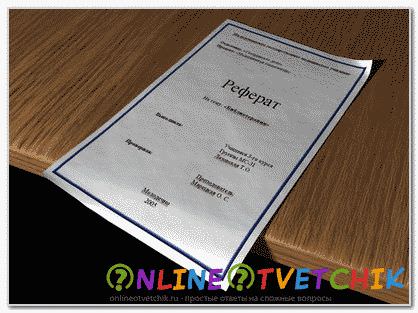
As a rule, lectures are given from school. It is from the title page that one gets acquainted with the content of the report. Therefore, its design must be accurate and correct. It is mandatory to indicate information about the educational institution, the topic of the report performed, the name of the student, and also write the year and town. Let's take a closer look at how to properly arrange the title page of the report. It is imperative to use large print.
At the top we write the name of our school or university, for example, "Secondary School No. 12 of the Ryazan Municipal Formation." Any abbreviation must be deciphered. This is usually done in capital letters. Go to the central part of the page and indicate the topic of the work. To do this, first write the phrase "report on the topic" and on the next line with a capital letter the name itself, for example "Healthy lifestyle". We retreat down and on the right we indicate the name and surname of the author, class, and also the full name of the teacher. At the bottom of the page we indicate the date of writing the report, and below the city with a capital letter.
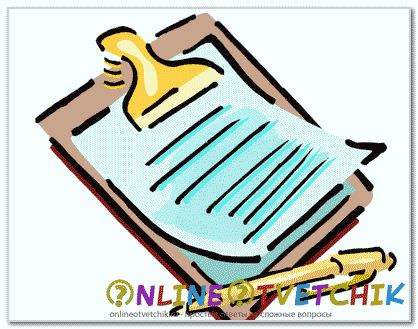
A correctly designed title page of the work indicates the student's attitude to his project. The title page is the first page of your project, but it is never numbered. Before starting to draw up it, you should take into account the standards of the educational institution and the teacher. At the top in the middle of the page we write the name of our school. Below we indicate the name of the work performed.
Having made an indent down the middle of the page, we indicate the name of your project, including the name of the subject. Remember that when you design the title page, the title of the topic is written without quotation marks. Then we go down and on the right side we indicate the name of the faculty, our group or class and the details of the author. Slightly below the initials of the head of the word "checked (a)". If you do not know how to arrange the title page correctly, see the example on the sample.
At the bottom of the page, in the center, indicate your city of residence. On the next line, we write the date of the task. It should be borne in mind that the word "year" is not indicated on the sheet. When filling out the title page, a period is never put at the end of a sentence. The only exception may be the title of the work, which consists of several sentences. However, after the last sentence, we do not put a full stop, respectively.
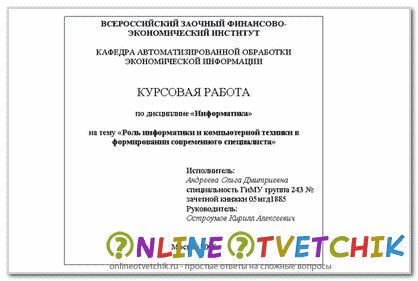
Coursework is one of the defining forms of a student's report on a particular subject. The rules for its registration in each educational institution may differ. But there are also generally accepted standards for its design. The title page is drawn up in A4 format with a font size equal to fourteen. The font should be standard - TimesNewRoman. Before starting to fill in the data on the page, you need to make indents: one centimeter on the right, three centimeters on the left, and two centimeters above and below.
Translated from Latin, title page means “inscription”, “title”. On this sheet information about the educational institution, faculty, topic is indicated term paper, subject, details of the student and his leader, as well as the locality and year of the work. The top line is filled with large letters, bold and centered. The title of the topic of the term paper is also written in the middle, but with a large font size and always in capital letters. We do not put a full stop at the end of the sentence. If the sentence is long, it can be written on two lines.
We write the data about the student at the bottom right, aligning it to the left. The name of the student is written in the genitive case. Skipping one line, we indicate the initials of the supervisor or teacher. The name of the head is written in the nominative case. To enter this data, we use a font size of fourteen. And finally, at the bottom of the page, we indicate the locality and the year of delivery of our work, aligning it in the center.